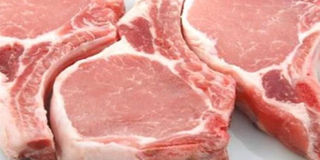Curing pork for longer shelf-life

Please educate me on how to cure pork to prolong its shelf-life because I don’t have a refrigerator. Girvan
Dear Girvan
Curing is a method of preserving foods such as meat, fish and vegetables by adding salt to draw moisture out. This makes the food inhospitable for micro-organisms that cause spoilage.
In pork curing, you can coat a pork cut with a dry rub containing salt and seasonings, or wet brine where the cut is submerged in a salty seasoned brine (a high concentration solution of salt in water).
Different pork cuts are cooked differently. Cuts that are tough are slow-roasted while the less tough ones can be quickly grilled.
Similarly, in pork preservation, different cuts should be handled differently since they have various characteristics that will affect the final flavour of the preserved product.
Pork cuts that are tough and fatty can be ground and preserved in casings as sausages. The lean and tender cuts are suitable for salting and can be preserved whole.
Hind pig legs work less than other parts like the shoulder hence this meat is tender. A whole leg is cured by thoroughly salting it in a cool place.
Since this is a large meat cut, the temperatures should be appropriate, therefore, a cool place in the house should be picked for curing. Pork loin can be cured by mixing salt, sugar, black pepper, garlic, cloves and thyme to make lonzino.
Answered by Faith Ndungi, Department of Human Nutrition, Egerton University
I am Aloyse. I want to know how one can succeed in watermelon farming. I planted quarter of an acre but they are not doing well.
Dear Aloyse
Watermelons are warm-season crops and they require long growing period of high temperatures.
Good vegetative growth requires 18-32oC, the optimal being 18-24oC. They do better with adequate water supply.
Within a growing season, at least 400mm of moisture will be required. Soils should be well-drained and with good water-holding capacity.
The pH should be 6.0-6.8. Watermelons have been grown successfully in sandy soils, where water supply is adequate. However, the best soils are sandy loam or silt loam.
Application of nitrogenous fertilisers is based on soil type. Soils with high organic matter require 80kg N/ha, while light soils require 140kg N/Ha.
The nitrogen fertiliser should be applied and incorporated into the soil at planting time. Phosphorus and potassium applications are based on soil tests, and both should also be applied at the time of planting.
The best melons are those raised under irrigation. Most of the soils under which the melons are grown are light and require frequent watering to maintain good growth.
Depending on the environmental conditions, 450-600mm of water is required within a growing season. Water can be applied through drip or furrow irrigation.
Use of sprinkler irrigation raises the humidity within the canopy and this leads to increased disease incidence. Weeds should be controlled, especially when the melon plants are young.
Weeds offer greater competition by shading the melon plants. Weed control can be achieved by application of black plastic mulches, cultivation, and use of herbicides that are registered for use in melons.
Answered by Carol Mutua of department of crops, horticulture and soils, Egerton University.
Kindly advice on suitable agribusiness ventures that will not tie me down considering I have a demanding full-time job. Sunday
Dear Sunday
There are many crops that can do well in the first season but remember you can’t grow a crop and then you don’t take care of it. If it is not you taking care for the crop, you can employ someone but also make sure you visit the farm regularly.
The plants will need to be weeded, pests and diseases controlled besides other management practices that vary depending on the crop.
You can try cabbages, sukuma wiki, spinach, strawberry, garden peas, potato, leeks, lettuce, pepino melon, French beans, indigenous vegetables such as spider plant, black nightshade, amaranth, rattle pod, jute mallow, vine spinach and Russian comfrey.
Answered by Carol Mutua of department of crops, horticulture and soils, Egerton University
How can I fatten bulls in a short time for sale? Kevin
Dear Kevin
Bull fattening is done in readiness for sale. Mostly during the harsh weather when we don’t have enough pasture and water, animals raised in the dry areas can be fattened with proper planning to fetch more.
Fattening of bulls requires a quality diet. This means doing high quality hay and having it in your store, making silage, making a concentrate to improve on protein and energy nutrition and also having minerals and vitamin sources that can be bought as premix.
Total mixed ration way of feeding is also encouraged. This is where you mix weighed proportions of grass, silage, premix and concentrates that meet the bulls’ nutritional requirement and offer them depending on their body live weight.
Dennis Kigiri, department of animal sciences, Egerton University




